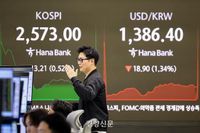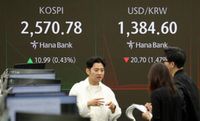On May 7, 2025, the won-dollar exchange rate closed at 1398 won, down 7.3 won from the previous trading day in the Seoul foreign exchange market. This marks a significant milestone, as it is the first time the rate has dipped below 1400 won since November 29, 2024, when it was recorded at 1394.7 won. The fluctuations throughout the day were influenced heavily by expectations surrounding trade negotiations between the United States and China, contributing to a sharp initial decline.
The day began with the won-dollar exchange rate starting at 1380 won, a substantial drop of 25.3 won compared to the previous closing price of 1405.3 won on May 2, 2025. This opening price is the lowest seen in approximately six months, since November 6, 2024, when it was 1370.4 won. The exchange rate experienced a brief recovery, rising to the 1400 won mark at one point during the trading session, but ultimately settled lower.
Market analysts attribute the volatility to several factors, including the recent strength of the Taiwan dollar and the anticipated progress in U.S.-China trade negotiations. As Scott Bessent, the U.S. Treasury Secretary, indicated that negotiations could conclude soon, market sentiment improved, leading to increased demand for the dollar among traders. This optimism was reflected in the dollar index, which showed a decrease of 0.43% to 99.363, indicating a weakening dollar against a basket of other currencies.
As the day progressed, the won-dollar exchange rate fluctuated, hitting a low of 1379.7 won and a high of 1402.5 won, resulting in a total intraday range of 22.8 won. The strong demand for the dollar from local investors, who had been unable to trade during the holiday period, contributed to the recovery from the initial drop.
According to analysts, the recent movements in the exchange rate are a direct response to the evolving landscape of U.S.-China relations. With the potential for an agreement between the two countries, expectations have shifted, leading to speculation that the won could strengthen further. Some experts predict that if the negotiations yield positive results, the won-dollar exchange rate could stabilize in the mid-1300 won range.
Despite these optimistic forecasts, there are warnings about potential risks. Analysts from NH Investment & Securities suggest that while the exchange rate may see a temporary decline, ongoing uncertainties surrounding trade negotiations and domestic political factors could lead to renewed volatility. They caution that if the U.S.-China talks falter or if domestic economic issues arise, the won could weaken again.
In the broader context, the won-yen exchange rate also saw movement, closing at 978 won per 100 yen, which represents an increase of 9.7 won from the previous trading day. This rise in the won's value against the yen further underscores the shifting dynamics in Asian currencies, as regional currencies have generally strengthened against the dollar during this period.
As the financial markets continue to react to these developments, the won-dollar exchange rate remains a critical indicator of economic sentiment in South Korea. Investors and analysts alike are closely monitoring the situation, particularly as the U.S. and China prepare for their first official dialogue since the beginning of the recent trade tensions. The outcome of these discussions could have significant implications not only for the exchange rate but also for broader economic conditions in the region.
In summary, the won-dollar exchange rate's movement on May 7, 2025, reflects a complex interplay of domestic demand, international trade negotiations, and broader economic trends. As the situation evolves, stakeholders will need to stay vigilant, as the potential for both upward and downward movements in the exchange rate remains high.





